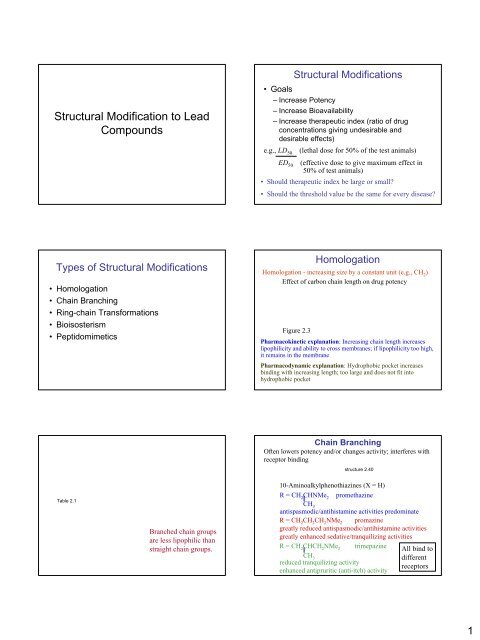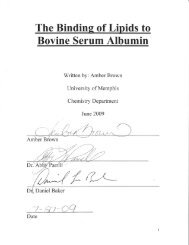Structural Modification to Lead Compounds
Structural Modification to Lead Compounds
Structural Modification to Lead Compounds
Create successful ePaper yourself
Turn your PDF publications into a flip-book with our unique Google optimized e-Paper software.
<strong>Structural</strong> <strong>Modification</strong> <strong>to</strong> <strong>Lead</strong><strong>Compounds</strong><strong>Structural</strong> <strong>Modification</strong>s• Goals– Increase Potency– Increase Bioavailability– Increase therapeutic index (ratio of drugconcentrations giving undesirable anddesirable effects)e.g., LD 50ED 50(lethal dose for 50% of the test animals)(effective dose <strong>to</strong> give maximum effect in50% of test animals)• Should therapeutic index be large or small?• Should the threshold value be the same for every disease?Types of <strong>Structural</strong> <strong>Modification</strong>s• Homologation• Chain Branching• Ring-chain Transformations• Bioisosterism• PeptidomimeticsHomologationHomologation - increasing size by a constant unit (e.g., CH 2)Effect of carbon chain length on drug potencyFigure 2.3Pharmacokinetic explanation: Increasing chain length increaseslipophilicity and ability <strong>to</strong> cross membranes; if lipophilicity <strong>to</strong>o high,it remains in the membranePharmacodynamic explanation: Hydrophobic pocket increasesbinding with increasing length; <strong>to</strong>o large and does not fit in<strong>to</strong>hydrophobic pocketTable 2.1Branched chain groupsare less lipophilic thanstraight chain groups.Chain BranchingOften lowers potency and/or changes activity; interferes withrecep<strong>to</strong>r bindingstructure 2.4010-Aminoalkylphenothiazines (X = H)R = CH 2CHNMe 2promethazineCH 3antispasmodic/antihistamine activities predominateR = CH 2CH 2CH 2NMe 2promazinegreatly reduced antispasmodic/antihistamine activitiesgreatly enhanced sedative/tranquilizing activitiesR = CH 2CHCH 2NMe 2trimepazine All bind <strong>to</strong>CH 3differentreduced tranquilizing activityrecep<strong>to</strong>rsenhanced antipruritic (anti-itch) activity1
Ring-Chain TransformationsTransformation of alkyl substituents in<strong>to</strong> cyclicanalogs, which generally does not affect potency.structure 2.40Trimepazine (2.40, X = H, R =Methdilazine (2.40, X = H, R =similar antipruritic (anti-itch) activities.NNMe 2Me) and) haveChlorpromazine (antipsychotic)(2.40, X = Cl, R = CH 2 CH 2 CH 2 NMe 2 ) and(2.40, X = Cl, R = CH 2 CH 2 CH 2 N )have equivalent tranquilizing effectsRing-chain transformation can have pharmacokineticeffects, such as increased lipophilicity or decreasedmetabolism.BioisosterismBioisosteres - substituents or groups withchemical or physical similarities that producesimilar biological properties. Can attenuate<strong>to</strong>xicity, modify activity of lead, and/or alterpharmacokinetics of lead.Classical IsosteresTwo classical isostere definitions:Grimm: groups having same # valence electronsErlenmeyer: groups with identical peripheral electron layersTable 2.2Non-Classical IsosteresTable 2.3Table 2.4Examples of Bioisosteric AnaloguesDo not have the samenumber of a<strong>to</strong>ms and donot fit steric andelectronic rules ofclassical isosteres, buthave similar biologicalactivity.2
Changes in Activity by BioisosterismIf the S in phenothiazine neuroleptic drugs (2.40) isreplaced by -CH=CH- or -CH 2 -CH 2 - bioisosteres,then dibenzazepine antidepressant drugs (2.43)result.Changes resulting from bioisosteric replacements:Size, shape, electronic distribution, lipid solubility, watersolubility, pK a , chemical reactivity, hydrogen bondingEffects of bioisosteric replacement:1. <strong>Structural</strong> (size, shape, H-bonding are important)2. Recep<strong>to</strong>r interactions (all but lipid/H 2 O solubility areimportant)3. Pharmacokinetics (lipophilicity, hydrophilicity, pK a ,H-bonding are important)4. Metabolism (chemical reactivity is important)Bioisosteric replacements allow you <strong>to</strong> tinker with whicheverparameters are necessary <strong>to</strong> increase potency or reduce <strong>to</strong>xicity.Bioisosterism allows modificationof physicochemical parameters•Multiple alterations may be necessary:•If a bioisosteric modification for recep<strong>to</strong>rbinding decreases lipophilicity, you may have<strong>to</strong> modify a different part of the molecule witha lipophilic group.•Where on the molecule do you go <strong>to</strong> make themodification?PeptidomimeticsPeptides are important endogenous molecules -neurotransmitters, hormones, neuromodula<strong>to</strong>rsPeptide drugs - analgesics, antihypertensives, antitumor agentsPeptides generally do not make good drug candidates• rapidly proteolyzed in GI tract and serum• poorly bioavailable• rapidly excreted• bind <strong>to</strong> multiple recep<strong>to</strong>rsPeptidomimetic - a compound that mimics or blocks thebiological effect of a peptide, but without undesirablecharacteristics•Use the peptide as a lead - modify <strong>to</strong> minimizeundesirable pharmacokinetic properties•Try <strong>to</strong> mimic structure of the peptide when it isbound <strong>to</strong> the target recep<strong>to</strong>r•Replace as much of the peptide backbone aspossible with nonpeptide fragments - leave thepharmacophoric groups•Initially, retain conformational flexibility, butthen refine <strong>to</strong> more conformationally-rigid analogs<strong>to</strong> hold groups in bioactive conformation.Phenylalanine PeptidomimeticsFigure 2.9Increased lipophilicity and conformationalrigidity - better absorption and poorrecognition by proteases3
Conformationally-Restricted PeptidesSecondary Structure MimeticsFigure 2.11Figure 2.10Scaffold PeptidomimeticsArg-Gly-Asp (RGD)common β-turn motifthat binds <strong>to</strong> recep<strong>to</strong>rsPeptide Backbone IsosteresPeptide amide bond replaced with alternative groupsTable 2.5structures 2.66-2.69(statine)RGD peptidomimeticsAssigned Reading• 2.2 through the end of 2.2E.4 and 2.2E.7• Problems 2.4 - 2, 5, 6, 7, 12• Part II – copy for in-class peer review 3/22– copy for grading 3/244
















